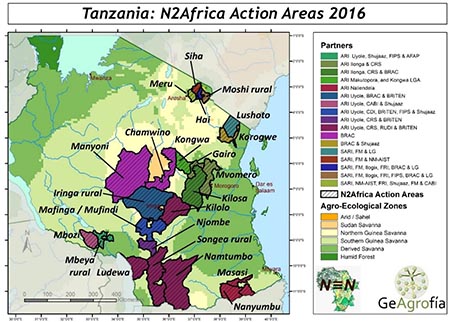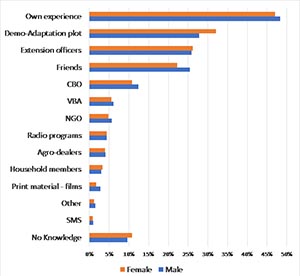In Tanzania, N2Africa and a number of related projects jointly developed and applied a range of innovative communication approaches to scale-up improved legume technologies. To assess the effectiveness of these communications approaches, N2Africa, the Centre for Agriculture and Bioscience International (CABI), Farm Radio International (FRI) and other partners designed a survey tool using Computer Aided Telephone Interviews (CATI). The survey consisted of two modules: the first module focused on farmer behaviour on beans and soyabean, their intention to buy seeds and inputs, and the availability of inputs; the second module focused on farmer exposure and learning through dissemination campaigns. A report with the results of the second module has just been uploaded on the N2Africa website [LINK], and we share some highlights here.
The target group for the survey were farmers from N2Africa and related projects (SILT, GALA and UPTAKE) in the main bean and soyabean growing regions in Tanzania (Figure 1). About 2900 farmers had been contacted for the first survey module, and over 1600 of these farmers could be reached a second time to complete the second module. From the farmers participating in the second module, 86% recently grew beans or soyabean, while 91% intended to do so in the next suitable season. The most important sources of information on beans or soyabean that respondents mentioned were their own experience (almost 50%) and demonstration or adaptation trial plots (30%) (Figure 2).
|
Figure 1. N2Africa Action areas - Districts in 2015-2018 |
Figure 2. Knowledge sources on beans and/or soyabean (n=1,646). |
Radio programs, another dissemination tool applied, were mentioned by 4.2% of the respondents. As part of the survey tool, these respondents subsequently listened to the introduction jingles of the five radio programs broadcast by Farm Radio International, and of these respondents 46% mentioned to have listened to one or more of the survey target radio campaigns (2% of the total of 1,646 respondents). Despite near equal exposure to the radio campaigns, women listened to fewer episodes than men: 80% of women listened to three or less episodes, against 37% of men, while half or more episodes of the target campaigns applied to 45% of the men and 8% of the women.
Respondents were also asked what they learned from the N2Africa and partners’ dissemination campaigns. Row cropping and earlier land preparation were the most frequently mentioned topics (37% of respondents), followed by the use of chemical fertilizer (31%), the use of quality seeds (22%), manure (21%,), pesticide (19%), herbicide (4%), inoculants (3%,) and PICs bags for storage (2%). The learning topics were in line with the topics mentioned in the first survey module about the uptake of practices, although the percentages of uptake were often much higher as not all topics would have been new to the respondents. For instance, the first survey module showed that PICS bags were used by 29% of the respondents, and chemical fertilizers by 44%. For seed, only 9% of the farmers had bought certified-quality seeds. However, on the question about farmers’ intention to ‘purchase certified seeds of the most preferred variety’, 68% confirmed this intention. This means that uptake of quality seed was mainly hampered by lack of availability/ inaccessibility, and not by awareness on the use of quality seeds. For ‘use of inoculants’, mentioned by only 3% as major learning topic, 8% of the farmers used, and about 20% of the farmers were aware of inoculants, of which 83% intended to buy inoculant. Of this 83%, three quarters did not have a source to buy inoculants. Like for seeds, uptake is therefore constrained by non-availability, but in contrast, low awareness is also an important limiting factor for the uptake of inoculants.
About two-thirds of the respondents mentioned that an ‘intervention’ had also influenced their learning. From these respondents, 85% mentioned demonstration plots, 10% radio programs and 7% information leaflets and posters. The importance of demonstration plots can be explained by the sampling strategy: 90% of the respondents were involved in N2Africa. ‘Interactions’ that led to learning were own experience, extension officers, and neighbours, friends and family. On private sector chain actors, 15% of the respondents mentioned community based organizations, 8% village-based advisors, 7% agro-dealers and 0.3% a private company. Almost all respondents were interested in receiving additional information, with the most popular topics being ‘quality seeds’, ‘markets’, ‘marketing’, ‘pesticide use’, ‘use of the right variety’ and ‘use of chemical fertilizer’. Markets and marketing were more frequently mentioned by men than women, and if these two topics are combined were mentioned by nearly half (42%) of the respondents.
Concluding, 85% of the respondents learned something on bean or soyabean, largely through demonstration plots. However, different types of dissemination approaches are useful for different types of messages: mass media like radio can be used for simple messages, e.g. to raise awareness on a new variety or the presence of a pest, but are less suitable for more complex information like the proper use or benefits of inoculants. Demonstration plots played an important role for such more complex messages. The investment required to achieve this level of effectiveness in learning was made possible through the N2Africa Public Private Partnership (PPP) approach, which is therefore a recommended mode for the implementation of value chain projects to contribute to increased awareness.
Edward Baars, IITA, Abuja, Nigeria and Esther Ronner Wageningen University & Research


